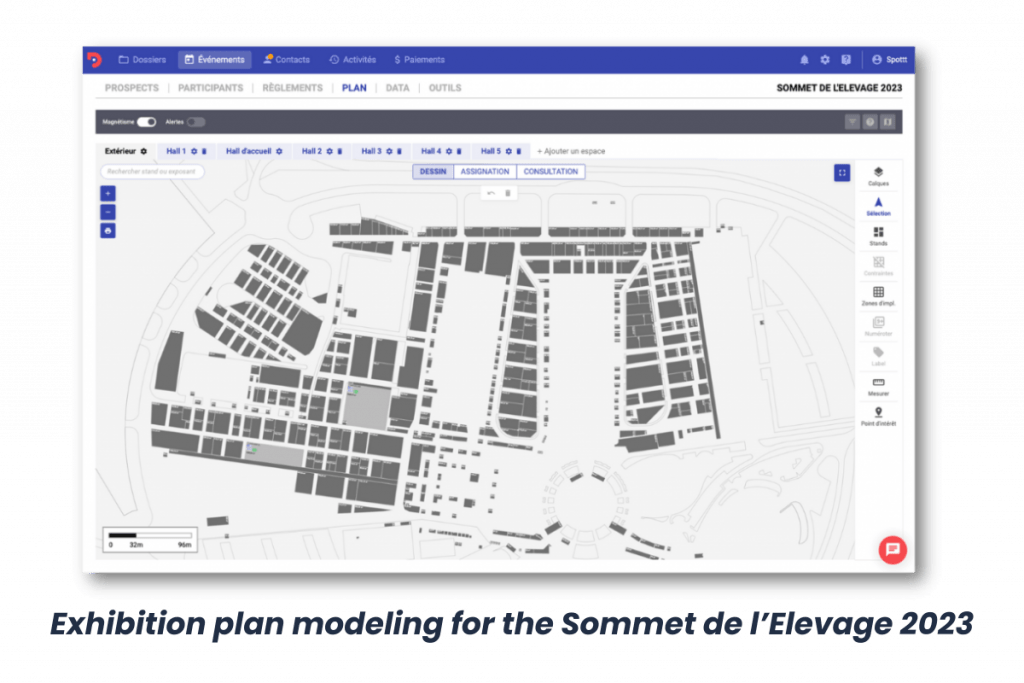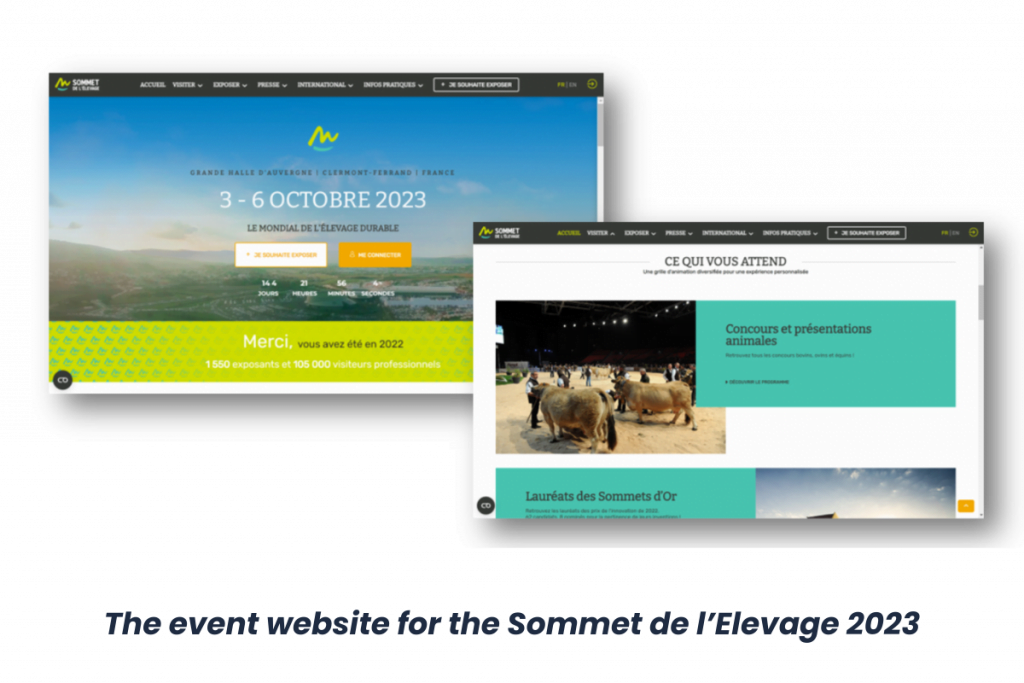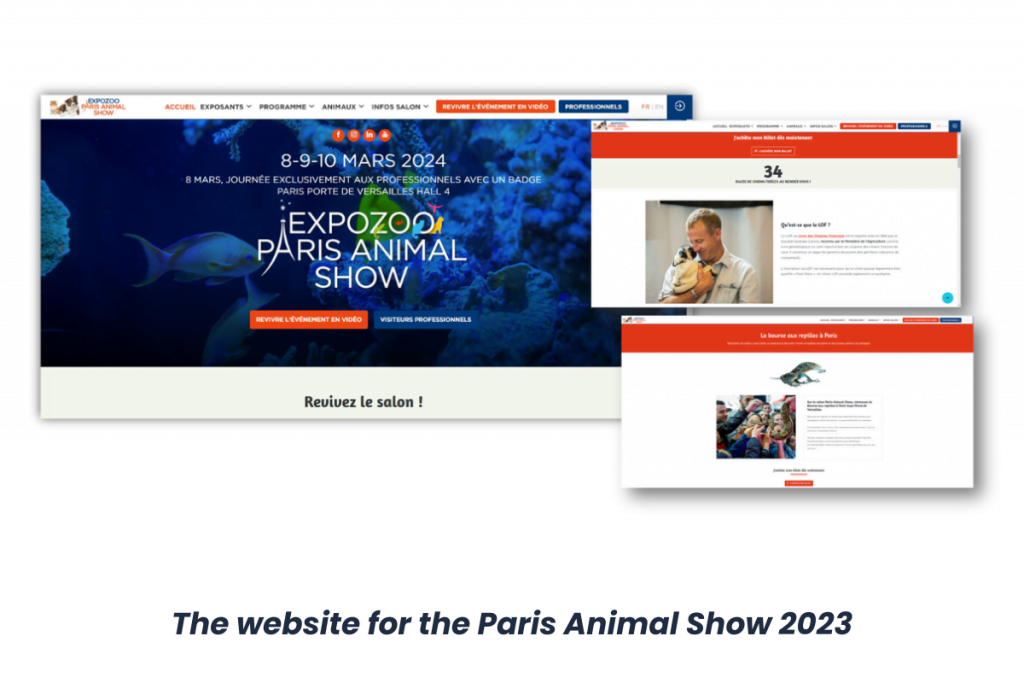It is often said that it takes 6 to 12 months to organise a trade show. Although this depends on a number of factors (size, complexity of the event, available resources, experience of the organiser, etc.), the time required can be optimised by asking the right questions and using the right tools.
This crucial subject was the main topic of our latest webinar, co-organised with Planexpo. The three speakers shared their advice on how to help events professionals organise a trade show, optimise event planning and make events memorable for participants.
Step 1: Preparing the marketing campaign (offers, floor plan, event website)
Organising a trade show usually starts with finding a name/theme, a date, and a venue. Then the organisers move on to the more operational stages:
- Defining the various offers for exhibitors: number and size of stands, costs, technical and other services, proposed communication, etc.
- Modelling the show’s floor plan: while more than 1/3 of organisers still use paper to finalise their floor plans and place their exhibitors, there are several digital tools available – the best known in the events sector being Autocad.
“It’s a simple plug-in: you draw the plan in Autocad and it synchronises in real time with Planexpo. I can keep up to date with all the details in one place with just 1 click.” Victor Berthon, Chief Development & Digital Officer at the Sommet de l’Elevage (over 220,000 m2 of exhibition space, including 90,000m 2 of stand space)

- Creation of the event website, a real communications showcase, which will serve as a foundation for all subsequent stages of the event’s organization.
“The inwink CMS is very easy for my whole team to access, and we can all get involved in the creation and manage it directly. In less than a day, we were up and running, creating pages and posting live information. The slightest change in the back office is immediately updated on the site, and that’s extremely practical.” Victor Berthon, Chief Development & Digital Officer at the Sommet de l’Elevage

Step 2: Digitalising the marketing of a show
While Excel, paper booking forms and other basic tools still have a bright future ahead of them, there is a definite trend towards speeding up the marketing phase of a trade show.
“The aim of an organiser is to sell square metres. In just 1 click, I can send an email to my potential exhibitors with a link to the online application form. The integration of Planexpo with inwink gives us this speed of execution and we get rid of all the red tape.” Florence de la Moureyre, CEO, Exposalons
In this context, the digitalisation of certain marketing actions is essential. The most advanced trade show organisers propose at least the following two features:
- Application form for potential exhibitors, which collects basic information:
- General company information and main contact
- Contractual and invoicing information
- Stand offers (choice, location, options, etc.)
- Communication and promotion
- Payment methods
- Exhibitor CRM, which includes the following functionalities:
- A list of participation requests and a global view of current files with all the information collected
- Real-time synchronisation of the floor plan with Autocad to allocate stands and manage specific requests
- Digitalisation of contracts and electronic signatures
- An automatic invoicing module and online payment to reduce time spent on the administrative phase
“Thanks to this automation, no more time is wasted on administrative details. We can concentrate on the more important tasks. We were at 83,000m2 in 2022, and this year we’re at 89,000m2. We’ve got a show with higher demand, but at the same time we can see that we’ve made progress in terms of speed to market.” Victor Berthon, Chief Development & Digital Officer, Sommet de l’Elevage.
Exhibitor registration form
directly integrated on the Sommet de l’Elevage website
Step 3: Communicate regularly about the show
While there are a multitude of communication methods to maximise registrations for a show, show organisers are increasingly focusing their efforts in two areas:
- An adaptable event website: this informational showcase should enable organisers to attract registrations, but also to convert those registrations into active participation, by displaying the following information:
- The programme, sessions and speakers
- The exhibitors present
- Side events: evening events organised alongside the main event
- Opportunities for making appointments with exhibitors and networking amongst participants
- …
“inwink has allowed us to create a website that is not just an information showcase, but a real community site where exhibitors have their own space and can do their own thing in terms of technical elements but also visibility, offering them opportunities such as advertising during sessions”. Florence de la Moureyre from Exposalons, organiser of Paris Animal Show
 Communication plan to retain registrants and engage exhibitors:
Communication plan to retain registrants and engage exhibitors:- Registrants: by sending regular emails to keep them informed (practical details, programmes and top speakers, badges, etc.) and encouraging them to register for conferences/workshops.
- Exhibitors: by implementing an upsell strategy that helps them increase their visibility and support them with tailor-made solutions such as advertising during sessions, logos highlighted on the exhibition floor plan, distribution of samples at the show, etc.
Step 4: Enhancing the participant’s experience
In the hustle and bustle of D-Day, exhibition organisers focus on two aspects in particular that can really make a difference in terms of image and overall experience:
- Welcoming participants: signing in, handing out badges, registering for certain sessions, etc. The welcome desk is the first point of physical contact with participants. You therefore need to pay particular attention to this phase, and make it as smooth as possible for your visitors. In this article, we detail our best practices for an optimal event reception.
- Providing an interactive map: whether to guide visitors to the various conference rooms or to meet exhibitors, the integration of a map of the show, accessible directly on the event’s website or application, makes it much easier for visitors to access information, but also helps to highlight exhibitors.
“Given that our event is predominantly digital, it’s important for us to make the most of the presence of our partners and the programme. Our map is more than just a map, it’s a cartographic vision of our event. In a single place, using the map of the world, which represents our event, you can access all the partners’ showcases. The idea is to have the smoothest possible access to information about the event”. Jean-Michel Cabon, Marketing and Communications Director, Esri France
Step 5: Preparing for the post-show period
To do this, organisers need to think about measuring several KPIs:
- Sales KPIs: sales generated, occupancy rate, progress of ongoing invoicing, etc.
- Participation KPIs: participation rate, number of contacts made by participants, number of business meetings held, etc.
- Global KPIs: these mainly involve measuring participant and exhibitor satisfaction levels. The satisfaction questionnaires will provide organisers with a wealth of information that will enable them to optimise and adapt future editions.
The post-show period is also a good time to think about:
- Sales rebooking: for the most efficient shows, this mission begins even before the official closing of the current edition. These organisers save time by automating exhibitors’ rebooking requests from one edition to the next.
“In just 1 click, we’ll send them a link where they can reserve their stand in the same location for next year.” Florence de la Moureyre, CEO of Exposalons
- Bringing the event’s brand to life and continuing to engage those audiences that were present at the show by setting up an online community: more and more organisers are taking the plunge and setting up a veritable “private LinkedIn”, enabling them to maintain relationships with their participants throughout the year.
“When we chose the tool to manage the Summit, this community aspect was essential. It’s all very well being in the spotlight for 4 days a year, but for the other 361 days of the year, no one is thinking about you. When you have a community, it gives you the means and a reason to communicate with its members.” Victor Berthon, Chief Development & Digital Officer, Sommet de l’Elevage

 Communication plan to retain registrants and engage exhibitors:
Communication plan to retain registrants and engage exhibitors: